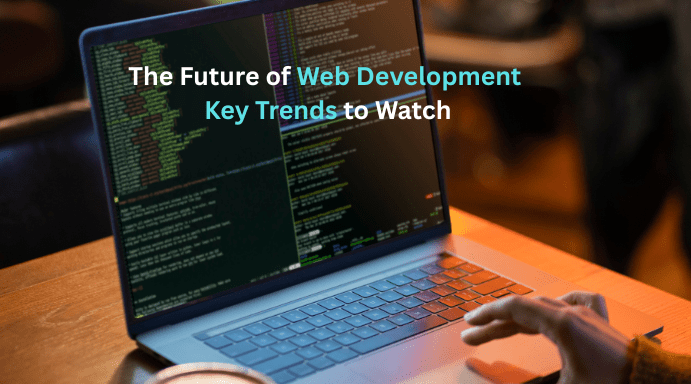In an era where technology is evolving at lightning speed, web development services, shaping the way businesses, consumers, and creators interact with the digital world. As we delve into 2024, several groundbreaking trends are poised to define the future of the web. Embracing these trends will be essential for developers and businesses aiming to stay ahead of the curve and deliver seamless, efficient, and modern web experiences.
AI-Powered Development is Revolutionizing the Web
Artificial Intelligence has progressed from a supporting role to becoming a central pillar in modern web development. In 2024, we are seeing:
- AI code generation tools like GitHub Copilot and ChatGPT reducing development time by suggesting or auto-generating blocks of code.
- AI-based UX personalization, which customizes user interfaces and content in real time based on user behavior.
- Chatbots and virtual assistants, powered by natural language processing, offering 24/7 support and enhancing customer engagement.
The adoption of AI is not only optimizing workflows but also making websites smarter, more intuitive, and more responsive to user needs.
Progressive Web Apps (PWAs) Take Center Stage
Progressive Web Apps are emerging as the future standard for app-like experiences on the web. Offering offline capabilities, lightning-fast load times, and a native app feel without requiring app store downloads, PWAs are becoming the go-to for businesses looking to increase user engagement.
- Companies like Twitter, Starbucks, and Pinterest have seen major improvements in conversions and retention after adopting PWAs.
- In 2024, more development teams are expected to prioritize PWAs over native applications due to lower costs and faster deployment.
The PWA architecture is ideal for delivering cross-platform compatibility, reducing friction in user experience and maximizing reach.
The Rise of Serverless Architecture
Serverless computing allows developers to build and run applications without managing servers, leading to greater scalability and efficiency.
- Major cloud providers such as AWS Lambda, Azure Functions, and Google Cloud Functions support event-driven, pay-as-you-go serverless models.
- This architecture allows developers to focus on writing business logic while the cloud provider handles provisioning, scaling, and maintaining the infrastructure.
In 2024, we foresee widespread adoption of serverless technologies, especially for startups and lean development teams seeking agility and cost-effectiveness.
Web3 Integration and Decentralized Applications
The decentralized web is no longer a concept—it’s becoming a foundational shift in the internet’s structure. Web3 technologies enable users to control their data, identities, and interactions on the web through blockchain-backed protocols.
- dApps are being built on platforms like Ethereum, Solana, and Polkadot to provide secure, transparent, and tamper-proof web experiences.
- NFT marketplaces, decentralized finance (DeFi), and DAO platforms are gaining traction, leading to new paradigms in user engagement and revenue generation.
In 2024, developers with blockchain expertise will be in high demand, as businesses seek to capitalize on this new wave of decentralized innovation.
API-First Development Is Becoming the Norm
With microservices and third-party integrations becoming essential, API-first development is now a best practice.
- Developers are designing robust and flexible APIs first, ensuring better scalability, faster development, and smoother integration.
- Tools like Swagger, Postman, and GraphQL have made API development and testing more efficient and collaborative.
In 2024, a solid API-first strategy will be critical for building modular, reusable, and maintainable applications.
Enhanced User Experiences Through Motion UI and Micro interactions
Motion UI and microinteractions play a critical role in delivering engaging and interactive experiences.
- Subtle animations, transitions, and feedback mechanisms improve user satisfaction and guide user actions.
- Frameworks like Framer Motion and Lottie have made it easier for developers to create visually appealing and responsive UI components.
This year, expect more websites to adopt advanced UI/UX patterns, enhancing usability without sacrificing performance.
Headless CMS Gains Ground for Content Flexibility
A headless CMS (Content Management System) decouples the content repository from the presentation layer, providing developers with greater control over content delivery.
- Popular solutions like Strapi, Contentful, and Sanity allow for omnichannel content delivery across web, mobile, IoT, and AR/VR platforms.
- Content creators can manage and push updates seamlessly while developers build highly customized frontends using frameworks like Next.js, Nuxt.js, and Gatsby.
The flexibility and scalability offered by headless CMSs will make them an essential part of the web development toolkit in 2024.
Cybersecurity by Design
With cyberattacks becoming increasingly sophisticated, security is no longer optional—it’s integral to web architecture.
- Zero Trust frameworks, HTTPS everywhere, and strict content security policies (CSP) are becoming industry standards.
- Integration of automated vulnerability scanning, multi-factor authentication (MFA), and encrypted APIs are now common practice.
- Compliance with data protection laws, such as GDPR and CCPA, is mandatory for avoiding legal and financial repercussions.
In 2024, every phase of development will prioritize security-first design principles to protect users and organizations.
The Continued Growth of Jamstack Architecture
Jamstack (JavaScript, APIs, and Markup) architecture is gaining popularity due to its performance benefits and scalability.
- Static site generators like Hugo, Gatsby, and Next.js offer blazing-fast load times and improved SEO.
- Content is served through CDNs, drastically reducing latency and increasing global availability.
As web performance becomes a core ranking factor for search engines, more businesses are migrating to Jamstack solutions.
Edge Computing and Faster Load Times
Edge computing brings data processing closer to the user, reducing latency and improving performance.
- CDNs like Cloudflare, Akamai, and Fastly offer edge functions that run server-side logic closer to the end-user.
- This shift results in faster page loads, real-time analytics, and smoother streaming capabilities.
In 2024, edge computing is becoming integral to optimizing performance, especially for global audiences.
Prepare for the Future of Web Development
The web development company in Noida landscape in 2024 is marked by innovation, performance optimization, and user-centric design. Staying ahead requires embracing cutting-edge technologies like AI, serverless computing, Web3, and edge architecture, while never losing sight of user experience, speed, and security.
Businesses and developers that adapt quickly to these trends will gain a competitive advantage, deliver superior digital experiences, and future-proof their web presence.
